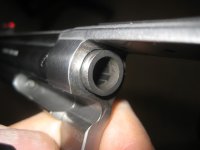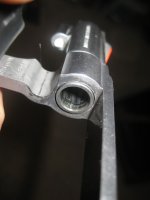So I've been battling lead splatter with my 686-5 around the barrel extension. The forcing cone is heavily leaded. I also get occasional splatter coming back to my face. I need to fix it.
I've spent quite a bit of time reading the literature and I think I want to chamfer the forcing cone to 11deg.
Before anyone asks the cylinder gap is .007 which although not ideal, is within spec.
Since I can't be sure that the lead in the forcing cone is the culprit and shaves off lead, or if the magnum loads are blowing out the lead rings from 38 shells, I need a super clean baseline.
I've been perusing the brownell's catalog and have determined that I can spend hundreds of dollars on my speculation.
For the cylinder, I'll soak it in solvent and brush it. Or if it needs it, I'll spring for the de-leader reamer. It's an expensive little tool, but I think it is one I can use in the future.
For the forcing cone, I've brushed quite a bit, but hasn't done much for me. Next up I was thinking of using a piece of "lead away" cloth. Outside of the taylor brass patch method, does anyone have any better ideas?
Once everything is spotless, I'll throw 100 magnums down range and see if she still spits and splatters. If so I think I'll need to buy the actual 11deg throat chamfer tool, as well as the incredibly high priced plug chamfer checker. That sounds like a fun 150$ project.
So base question is how to get everything super clean to establish a baseline before I dump money on the throat chamfering kit?
While we're on the subject, I took a looksy at the forcing cones of my other smiths and they look fine, except my 940 has heavy machining marks. It almost looks like a dull chamfer bit chattered on the throat. Is this normal? If I get the chamfering kit this makes me want to get the polishing bit for it as well. See 2nd pic


I've spent quite a bit of time reading the literature and I think I want to chamfer the forcing cone to 11deg.
Before anyone asks the cylinder gap is .007 which although not ideal, is within spec.
Since I can't be sure that the lead in the forcing cone is the culprit and shaves off lead, or if the magnum loads are blowing out the lead rings from 38 shells, I need a super clean baseline.
I've been perusing the brownell's catalog and have determined that I can spend hundreds of dollars on my speculation.
For the cylinder, I'll soak it in solvent and brush it. Or if it needs it, I'll spring for the de-leader reamer. It's an expensive little tool, but I think it is one I can use in the future.
For the forcing cone, I've brushed quite a bit, but hasn't done much for me. Next up I was thinking of using a piece of "lead away" cloth. Outside of the taylor brass patch method, does anyone have any better ideas?
Once everything is spotless, I'll throw 100 magnums down range and see if she still spits and splatters. If so I think I'll need to buy the actual 11deg throat chamfer tool, as well as the incredibly high priced plug chamfer checker. That sounds like a fun 150$ project.
So base question is how to get everything super clean to establish a baseline before I dump money on the throat chamfering kit?
While we're on the subject, I took a looksy at the forcing cones of my other smiths and they look fine, except my 940 has heavy machining marks. It almost looks like a dull chamfer bit chattered on the throat. Is this normal? If I get the chamfering kit this makes me want to get the polishing bit for it as well. See 2nd pic


